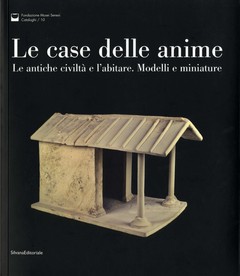Museo delle Culture uses cookies to improve the user experience. If you need more information click on the privacy page. Privacy policy X
25 June 2011 - 16 October 2011, Museo Civico e Archeologico delle Acque di Chianciano Terme
The project ‘Le case delle anime’ (Houses of the Souls) was designed by the Museo delle Culture (MCL) in collaboration with the Fondazione Musei Senesi and the Museo Civico Archeologico delle Acque of Chianciano Terme. It also received the support of several other sponsoring institutions: The Province of Siena, the City of Chianciano Terme, Vernice Progetti Culturali, Monte dei Paschi di Siena Foundation, Monte dei Paschi di Siena Bank, the region of Tuscany, the Archdiocese of Siena-Colle of Val d’Elsa-Montalcino, the Chamber of Commerce of Siena, the City of Siena, the Diocese of Montepulciano-Chiusi-Pienza, the University of Siena and Fisiocritici’s Academy. One of project's outcomes is thetemporary exhibition ‘Le case delle anime. Le antiche civiltà e l’abitare. Modelli e miniature’, which includes over thirty works from major Italian and Swiss Museums, and is displayed in the Museo Civico Archeologico delle Acque in Chianciano Terme.
‘Le case delle anime’ are architectural models of buildings with various natures, such as homes, huts, temples, barns, towers, etc. They may have had various functions, and were mainly discovered in funerary and votive deposits, but also in dwellings. Some were certainly used as cinerary vases (proper resting sites for the souls) whiles others were used as votive offers to divinities, or alternatively as cult tools during religious ceremonies. Such miniature models were found throughout the Mediterranean basin and in Mesopotamia, but also in China, in some cultures of Mesoamerica and in other countries. The earliest examples date back to the sixth millennium BC and were made by the Neolithic cultures of Thessaly (Greece).
The exhibition is divided into sections and covers some of the most relevant themes related to ancient architectural models: the contexts in which they were found, their functions, the miniaturisation and finally the relationship between the models and the actual architecture. A section is also dedicated to canopies: terracotta cinerary urns with anthropomorphic characters, which constitute a very peculiar heritage in Etruscan funerary art, and specifically in the area of Chianciano Terme. The project produced an anthropological analysis to demonstrate that ‘Le case delle anime’ actually do materialise an implied tendency. Since Antiquity, they tend to miniaturise what exists and characterize the artistic and material production of cultures. Did man always need to keep his home and belongings in the palm of his hand? What was the main function of these models? And what is their relationship with the immense world of miniatures that still dwells in our collective imagination today, and is colonized by a myriad of toy soldiers, trains, souvenirs and bonsai?
